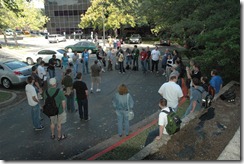 If you ask most any organization, they will tell you how much they value their customers. How much they want their feedback. And they show this by having events, or conferences, or demos and show off the latest widget, or plan, or feature to their customers. And then they wait. Wait for what, you might ask?
If you ask most any organization, they will tell you how much they value their customers. How much they want their feedback. And they show this by having events, or conferences, or demos and show off the latest widget, or plan, or feature to their customers. And then they wait. Wait for what, you might ask?
The amazing flood of Astoundingly Amazingly Great Ideas from their customers. Perfectly fit into bite-sized questions that answer exactly what the company wants.
And they end up waiting for a long time. Baffled, the company leaves the conference frustrated at the lack of communication from their customers. Not surprisingly, the customers also leave frustrated at not feeling like the company was interested in what they had to say.
Yesterday I attended a public session on “light rail†– basically a local train system – for the county just south of us. I say “countyâ€, but Hillsborough County is actually bigger than 7 states in the US. Throughout the session, I learned that the team working on the light rails proposal – made up of County staff and HARTLine (the local bus company) staff – was looking for the following information from the public meeting:
- Should we put a referendum on the ballot to increase the sales tax to pay for transit improvements?
- What mix of transit (train, bus) and non-transit (bike paths, roadway) projects should be included?
- What routes do people expect to use often? (For example, this meeting was held at a very large retirement area, so many of them wanted to be able to go from there to the local Veteran’s hospital which is about a 50-minute drive)
- What do people like or not like about the proposed routes?
These are all very good questions, and the answers would certainly help the county leaders figure out the next steps. But that’s not what happened. Instead what happened was the following:
Thanks for coming out! Here’s the plan we’ve spent 2 years putting together. As you can see, our maps and documents clearly outline the impact to every single area in our county without actually having maps and documents showing the impact to your specific area. The referendum will be on the November ballot, and we’ve allocated 75% of the funds for transit activities, and 25% for non-transit activities. The list of each of the funded initiatives is here. Any questions?
Any questions? Ok, so the above wasn’t a direct quote – but it does cover a summary of what happened. They sat everyone down, showed them a video about the “plan†(not “proposed planâ€) and at the end, split them into two groups to “answer their questions†about the transit and non-transit activities. At no point did they raise that this was a proposal they wanted feedback on or that they wanted to tweak. Nor did they ever just list the questions they wanted. The list above came from my observations of the group and the feedback from the leaders in the meeting.
Not surprisingly, there was a lot of animosity in the meeting as people felt a “plan†had been pitched that they had no say in. This is not different from other “focus groups†or “roundtables†where it’s more of a marketing gimmick than a chance to truly collaborate.
Now, imagine if the meeting had been started by the leaders showing a “transportation proposal†and simply listing the questions above – the ones they really wanted the answers to. Even better, the transit/non-transit projects and the route plans could have been broken down and the people in the room could have helped prioritize them – either by having whiteboards, or by using various Innovation Games such as “Buy a Feature†or “20/20 Visionâ€. Suddenly the participants have a focus and a realization that they can have some input into the process. Before you know it, the company is getting great feedback and suggestions, the participants are feeling heard, and everyone starts feeling much more satisfied that they could express the things they wanted to express.
So the next time you are gathering a group of your customers together, think not only about what you’d like to hear from them, but how you can truly engage them and communicate that what you’d like isn’t just a comment, but a partner.